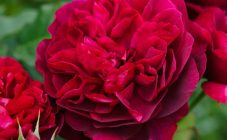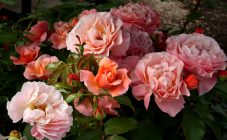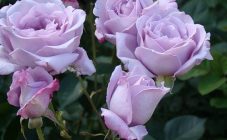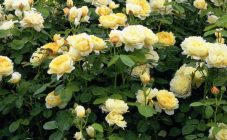Content:
The most beautiful varieties of garden roses and modest forms of wild-growing species are vivid representatives of the wild rose genus, selected after long selection work.
Rose bushes are not only spreading, but also pyramidal. The height of hybrid tea plants reaches 90 cm and more, while the miniature group is rather squat, its representatives do not exceed 35 cm.In whip-like roses, the length of the shoots can reach 6 m.
The history of the creation of the Belvedere variety
Rose Belvedere belongs to the class of hybrid tea roses, it is "scrub" - that is, a shrub. At first, roses related to scrubs had powerful tall shoots, but over time, shorter plants began to be included in this category. All of them bloom for a long time, are very unpretentious, have a relative resistance to cold weather and a high resistance to various kinds of diseases.
The rose was bred in 1996 by a German breeder Hans Jurgen Ewers (Rosen-Tantau, Itersen). In 2002, it was presented in Germany, and a little later, in 2006 - in the UK (organized by Pocock’s Nurseries).
In France, this is the name given to garden pavilions or pavilions installed in especially beautiful places, and in Europe - to palaces.
Qualitative characteristics and features
Rose Belvedere is not very tall, therefore, to decorate the landscape on the personal plot, it is better to give it a place in the middle ground. For example, along the curbs, together with small bushes. So you can disguise one feature of the plant - during abundant flowering, the lower leaves may begin to crumble, thereby exposing part of the stems.
Features of the Belvedere bush rose:
- the rose has the shape of a bush, the height of which, under the most favorable conditions, can reach 150 cm, and the width is 120 cm;
- flowers are orange-pink, about 12 cm in diameter, with varying numbers of slightly wavy petals, on average from 26 to 40;
- inflorescences most often consist of 5 rounded buds, which, when blooming, turns into a cup-shaped;
- there are single flowers and inflorescences of three buds;
- leaves are dark green, glossy, medium in size.
The bright orange buds gradually begin to acquire a delicate peach shade as they open. The smell of flowers is sweet, sometimes even spicy, with a subtle aroma of spices. The flowering period is long. When burned out in the sun, the color of the roses hardly changes, only slightly shifting towards pink. Moreover, in the middle, the flower still remains orange.
To get strong plants, you need to choose healthy, high-quality seedlings when buying.
Planting and breeding
Rose scrub Belvedere grows best in fertile and drained soils, with low acidity (pH = 5.5-6.5). It should not be grown in swampy or waterlogged areas - it can get sick with black spot. Groundwater should be at a depth of at least 1 m. Planting density is not more than 4 plants per 1 m². The distance between groups in one landscape composition should be from 0.5 m to 2 m.
In a hole 60 cm deep, drainage is laid - crushed stone or small stones, with a layer of no more than 10 cm.Then a layer of humus or compost similar in depth. Garden soil is poured in the same layer, but not leveled around the edges, left in a slide. The root collar - the place where the graft was made, is deepened into the ground, which contributes to the formation of stems above.
The most widespread is the vegetative method, which makes it quite easy to root and grow a flower you like from a bouquet in your garden. Its description is quite simple. All varietal characteristics are preserved, and cuttings, with such a rapid development of the shrub, you can always prepare a lot.
To propagate a rose, you need to cut off a shoot with a thickness of at least 0.5 cm with a clean garden knife. The length of the cutting should be about 15 cm, there are two or three buds on it. Rooting the cutting is done as follows:
- prepare the soil - it is disinfected and placed in a box;
- cuttings of a Belvedere rose are placed in a suitable growth stimulator and kept in it for a day;
- when planting in a box with soil, the cuttings are buried on one kidney and give them an inclination of 45 °;
- watered, put in a greenhouse, greenhouse or covered with garden film.
When a sufficiently developed root system is formed in the cuttings of a rose, they are transplanted to a permanent place.
Planting and caring for a Belvedere scrub rose is very simple. Particular attention should be paid to sanitary pruning and bush shaping. In any case, they are performed extremely moderately.
During spring pruning, 5 strong stems with buds are left (up to 8 pieces per one). Remove damaged and weak ones. If the height of the stem is more than one meter, then it is pruned by 40 cm. This is done because the buds of scrubs after winter are activated for a rather long time, and strong pruning can lead to poor bud formation. Whereas with the formation of branches of the second order, flowering will become even more abundant.
Anti-aging pruning should be done every five years. Remove and prune old shoots and cut off side shoots by one quarter. In autumn, young juicy stems are shortened by 1/3, as they usually freeze out.
The rose bush must be prepared for the winter period. Loosen the ground around it for better aeration, remove all weeds. Long stems must be gently bent to the ground and pinned. The shoots should not be allowed to lie directly on the ground, which at a certain period may be very wet. Fir branches need to be planted. Covering material is placed on top of the frame and sprinkled with earth. In good weather, in April or May, they begin to gradually ventilate the bush, slightly opening the sides of the shelter.
Taking care of the Belvedere rose in summer is not difficult. It is necessary to ensure that pests do not appear and water it in a timely manner, in the morning or in the evening. It is advisable to pour water exactly at the root, without getting on the leaves of the rose.
Advantages and disadvantages of the variety
Growing a shrub is an exciting experience. Many amateur flower growers are attracted by such advantages of the Belvedere rose as ease of care and endurance.
The advantages of this rose include the fact that this variety blooms very early and throughout the summer period, before the onset of cold weather, it is covered several times with beautiful and fragrant flowers that do not fall off for a long time.
However, if the site for the Belvedere is under hot sun rays throughout the day, then the waves of bloom will end very quickly. There may be a possibility of burns on delicate petals.
It differs from another popular shraba, La Villa Cotta, in that it takes root easily. At the same time, the comparison is not in favor of the Belvedere. For example, the Agness Schilliger variety is more resistant to disease.
Shrub roses Belvedere look spectacular both in the center of the flower bed and in a separate group. All of them bloom for a long time, are very unpretentious, have relative resistance to cold weather, are suitable not only for the Non-Black Earth Region or the Volga Region, but also for Siberia.















